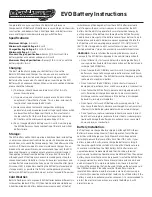
EVO Battery Instructions
Congratulations on your purchase of a Ballistic Performance
Components EVO Battery. EVO batteries are very different in chemistry,
construction, and behavior than a traditional lead-acid battery. Here
are some things to consider while using your EVO battery:
Specifications:
Maximum Voltage:
14.4 volts
Minimum Charged Voltage:
13.2 volts
Charged Resting Voltage:
13.2 volts-13.7 volts.
Minimum Voltage:
8.0 volts
Standard Charge Specifications:
2amps @ 13.2 volts until the
battery reaches a maximum voltage of 14.4 volts
Maximum Charge Specification:
10amps @ 13.2-14.4V or until the
battery registers 14.4V
Charging:
The best method for charging your EVO battery is to use the
Ballistic EVO Advanced Charger. You can also use a conventional
automotive or motorcycle based charger to recharge your EVO
Battery, but be sure you don’t under charge or over charge the EVO
Battery with an unknown charger. When using a conventional charger
please check the following:
1.)
The charger should have an automatic cut-off at 14.4V to
prevent over charging.
2.)
If you are using an automatic charger, be sure it does not have
an automatic ”desulfication” mode. This is a lead-acid specific
function that can damage the EVO cells.
3.)
Some conventional automatic chargers have charging
parameters based around lead-acid voltage specifications which
are lower than EVO voltage specifications. If your automatic
charger shuts off at 12.8 volts then it will never fully charge an
EVO battery with a minimum charged voltage of 13.2v.
4.)
Do not charge a Ballistic battery over 14.4 volts. Over charging
the EVO Battery may cause overheating of the cells and critical
battery failure.
Storage:
The EVO battery will not discharge like a traditional lead-acid battery
so unless your powersports vehicle has a parasitic draw like an alarm,
immobilizer, or LowJack that draws energy from the battery when the
switch is off, there is no need to use a maintenance charger. If your
bike does have a parasitic draw, we recommend the use of the EVO
Advanced Charger as a maintenance charger or simply disconnect
the negative terminal from the battery. It is important to note that
although your EVO battery may have more cranking amps than the
conventional lead-acid battery, it may also have less amp/hours and
will be affected more dramatically by a parasitic draw. We offer Quick
Disconnect Kits to make disconnecting the EVO battery for extended
storage as easy as possible. If left static (nothing drawing from the
battery) an EVO battery will discharge at a rate of around 10% per year.
Cold Weather:
Ballistic Performance Components EVO batteries behave differently in
cold weather (below 32ºF or 0ºC) than traditional lead acid batteries.
A traditional lead acid battery delivers maximum current at the first
initial draw and then degrades from there. EVO batteries actually
get stronger with each successive draw. In cold weather the EVO
battery has the ability to generate its own internal heat energy by
putting a draw on the battery. In cold weather, the EVO battery may
need to have a draw put on the battery several times before it is up to
temperature and ready to deliver maximum amperage. We rate the
EVO battery with an operating environment of 0ºF (-18ºC) to 140ºF
(60ºC). We strongly advise all of our customers to view our “cold
starting procedures” video on our website: www.ballisticparts.com.
WARNINGS
– Failure to follow the warnings below may result in
damage to the EVO Battery, damage to the vehicle, injury or death.
•
Do not attempt to start your vehicle with a discharged battery. If
your vehicle has trouble starting, check voltage of the battery and
recharge the EVO Battery.
•
Do not charge the EVO Battery over 14.4 volts. Overcharging the
battery may cause cell damage and in extreme cases melt down,
rupture, or combustion. The EVO battery will recharge very quickly
compared to a lead-acid battery.
•
Do not short out the EVO Battery. A hard short will cause cell
damage and in extreme cases melt down, rupture, or combustion.
•
Do not allow the EVO battery to become discharged below 8.0
volts. Excessive discharge from a parasitic draw or accidental
discharge may cause cell damage. If the battery is discharged
below 8.0v, recharge immediately.
•
Do not jump start your EVO Battery with a running vehicle. This
may cause the battery to become overcharged. Do not jump start
if below 10.0v. Recharge immediately with an external charger.
•
Do not puncture, rupture, submerge in liquid, or expose to direct
heat. Puncture, rupture, exposure to direct heat or submerging in
liquid will damage the battery and in extreme cases cause melt
down, rupture, or combustion.
Battery Installation:
EVO batteries are charged before shipping. Although EVO Lithium
Batteries have an exceptional self-discharge rate of only 10% per
year, they will discharge over time. Please check voltage before
installing to ensure that your battery has at least 13.2 volts. If your
battery is below 13.2 volts, please charge the battery according to
the charging specifications listed on this sheet. EVO batteries are in
some cases smaller than the OEM battery. EVO batteries are not
original equipment replacements and the size, shape, terminal
location, and terminal configuration may be different than the original
battery. Some modification may be required to install the EVO battery
in your powersports vehicle. We sell several cable extension kits and
quick disconnect kits to aid in installation. Also, there is foam that
comes in the packaging that can be used to take up the extra space in
the OEM battery box. Please be sure that the battery is secure,
insulated from vibration, and the terminals are free from coming in
contact with conductive material that could short out the battery. If the
battery is used in an extremely wet environment, it is recommended to
protect the electrical connections, especially the BMS port, with
dielectric grease.


